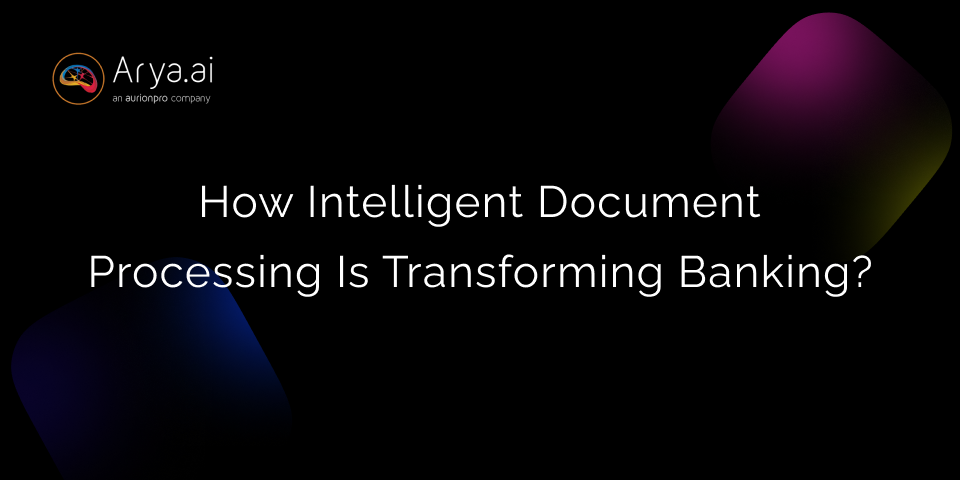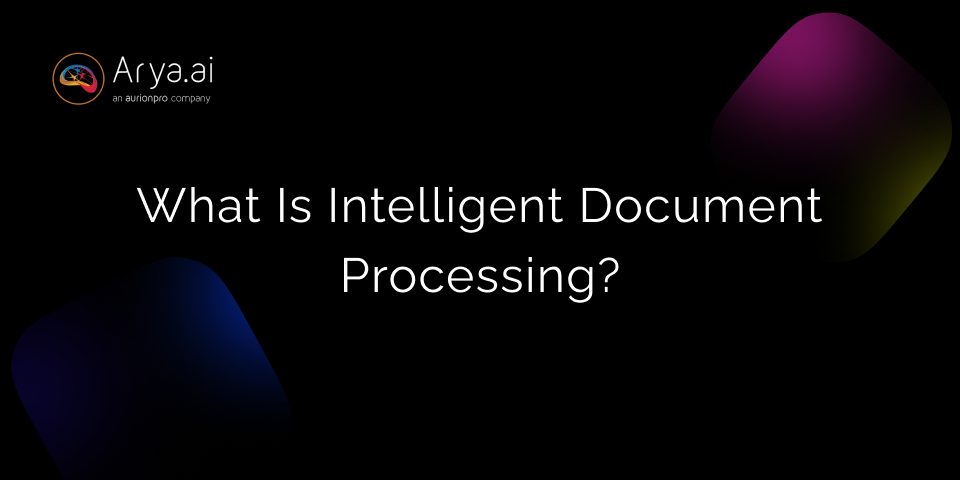The whole foundation of the banking sector rests upon heaps of documents. In the past, banks struggled to manage this vast amount of data in paper documents. Now, even after the majority of banking data is found in online forms, PDFs, emails and other digital formats, it all remains unstructured.
Unstructured data in bank statements, tax forms, financial statements, credit reports, contracts, and handwritten documents, of all the customers combined, is extremely difficult for banks to utilize efficiently; and all this makes up 80% of the total data that banks hold.
A typical mortgage application may contain up to 20 different forms at a time when even modern Document Management Systems (DMS) grapple to keep up with 20 to 30 types of data points. This is why most banking institutions have large inactive document archives with a ton of unstructured data. To make matters worse, only 3% of all this unstructured data can be evaluated.
But with Intelligent Document Processing (IDP) at the helm, banks can leverage the power of AI and machine learning to automate the extraction, classification, and processing of unstructured data to convert them to structured and useful data. This blog gives you detailed and practical insights into how IDP is transforming banking operations.
What is Intelligent Document Processing in Banking?
Intelligent Document Processing (IDP), or AI document processing (as it’s commonly called), is the use of Artificial Intelligence (AI) to simplify document handling in industries with heavy dependence on data from documents, which makes it an ideal candidate for banks that receive high volumes of data every passing minute. In simple words, Intelligent Document Processing uses AI to automate data extraction and simplify document accessibility for bank employees.
Traditionally, bank employees process and review documents manually, which takes time and is expensive. Intelligent Document Processing, on the other hand, uses AI, ML, deep learning, natural language processing (NLP), computer vision, and OCR to process information from all documents, making it possible for IDP to "read" and “understand” unstructured documents, just like us (but much faster).
Intelligent Document Processing can extract data in all formats, including PDFs, scans, emails, and handwritten documents. The technology works through several stages:
- Data Extraction: With OCR and computer vision, IDP extracts information from documents.
- Classification: NLP and machine learning algorithms classify documents into different categories.
- Separation and Validation: The extracted data then gets separated into relevant fields and validated for accuracy and completeness.
- Enrichment: IDP enriches the extracted data by cross-referencing with other data sources.
- Integration: Finally, the processed data is added to the bank's existing systems, ready for use in all banking operations.
Read more about Intelligent Document Processing and its underlying technologies.
Importance of Intelligent Document Processing in Banking
The reason why Intelligent Document Processing is essential in banking is because it addresses several critical needs within the industry:
- Handling Big Data: Banks have vast amounts of customer data, which is mostly in inaccessible formats. IDP converts this unstructured data into useful insights that help the banks to grow.
- Higher Efficiency and Lower Costs: Manual document processing with a lot of human capital is time-consuming, error-prone, and expensive. IDP automates these tasks, freeing skilled bank employees for higher-value work and significantly reducing costs.
- Compliance and Reducing Risk: With stricter banking regulations coming into place, banks need accurate data extraction and verification. IDP technology is compliant with the latest KYC and AML regulations, minimizing errors and document fraud risks.
- Keeping up with Consumer Demands: Consumers today expect quick and efficient services, regardless of the industry. IDP allows for faster loan approvals and customer onboarding, which improves customer satisfaction and helps banks compete with fintech companies.
- Enabling Straight-Through Processing: IDP is a must-have for banks moving towards straight-through processing (STP), which aims to automate financial transactions from beginning to end, improving speed, accuracy, and scalability.
Real-World Applications of Intelligent Document Processing in Banking
Loan Application Processing with Intelligent Document Processing
Loan applicants need to provide a variety of documents like ID proof, address proof, income proof, bank and other financial statements. All these documents are produced at different times and documents like financial statements change formats from bank to bank.
This demands manual processing of loan application documents even with active digitization in place. Intelligent Document Processing transforms these paper-based and unstructured digital bank forms into completely accessible machine-readable documents in a matter of seconds.
IDP identifies and classifies different document types, such as bank statements, income proofs, and address proofs, to extract relevant data. It gets information, like cash inflow and outflow every month, from bank statements and compares it against other financial documents, such as income proofs and expense bills. Simultaneously, data from government IDs gets cross-checked against public databases.
Using all this information and intelligent clause detection built right into the Intelligent Document Processing software, it can find out whether the loan applicant meets the bank’s lending criteria. This data gets automatically entered into the bank's systems, even if it is third-party software, and gets routed to the appropriate bank personnel for final approval, leading to a considerable drop in processing time.
Customer Onboarding and KYC
In the past, front-desk bank employees manually input customer information into the system and uploaded scanned images of documents for verification later. With Intelligent Document Processing, these manual processes can be eliminated. It uses OCR to convert scanned images into machine-readable digital documents. Then, AI classifies the document type and verifies the details.
When a customer decides to open a current account, they usually have to submit documents like a driver's license, birth certificate, credit score report, and tax reports. IDP platforms can extract customer demographics and financial details from these documents and compare them against each other to ensure validity. This information then automatically fills in online forms and initiates the next steps.
Intelligent Document Processing also helps banks in Know Your Customer (KYC) processes by automatically verifying customer identities and assessing risk. For example, IDP can extract relevant information from documents such as Aadhar, driver's licenses, and passports. This information gets integrated into the bank's KYC process where it gets checked for completeness and data consistency.
By automatically collecting and validating necessary documentation, Intelligent Document Processing speeds up customer onboarding while, making the KYC process more transparent, efficient, and error-free.
Compliance and Fraud Detection in Banking Using Intelligent Document Processing
Intelligent Document Processing (IDP) promises better compliance and fraud detection in banking by improving data accuracy:
1. Compliance
- KYC and AML regulations: IDP helps banks comply with KYC and Anti-Money Laundering (AML) regulations. As IDP automatically extracts and verifies customer information from government-issued IDs and financial records, it ensures data accuracy and reduces the risk of compliance violations and potential fines.
- Data Security and Compliance: IDP platforms can store extracted data on country-specific secure servers such as GDPR for Europe and SOC-2 for the United States. This reduces the risk of data breaches and helps banks handle sensitive customer information responsibly.
2. Fraud Detection
- Automated Fraud Detection: You can integrate Intelligent Document Processing platforms with fraud detection engines to find suspicious activities. By analyzing documents and transactions and cross-checking them with verified documents, IDP can detect anomalies and flag potentially fraudulent activities for further investigation by banking officials.
- Improved Accuracy in Fraud Detection: IDP's ability to extract and verify information faster makes it easier for banks to find fraudulent documents, such as forged ID cards. This reduces the risk of financial losses due to fraud and improves the security of your banking operations.
By simplifying compliance processes and improving fraud detection systems, IDP mitigates risks, reduces costs, and improves the efficiency and security of banking operations.
Read more: How lenders can leverage AI-powered document fraud detection systems?
Invoice and Payment Processing
Invoices arrive in various formats and designs, which means manual identification is needed to match purchase orders (POs) and receipts. However, using an IDP system can help to reduce the costs of manual labor, make faster payments, detect inconsistencies, and prevent fraud. Also, with IDP you can avoid the inefficiencies and risks in manual invoice processing. Invoice extraction is transforming banking by accurately extracting and processing invoice data.
Banks commonly use invoices to provide working capital to businesses to reduce risks compared to traditional loans. This process, known as factoring, generates income for banks and creates connections with small to medium enterprises (SMEs). These connections may lead SMEs to engage with more banking services in the future.
Other Use Cases for Intelligent Document Processing in Banking
- Processing Bank Forms: Banks process a high volume of forms for activities like retirement account withdrawals, for example. These forms are often paper-based and handwritten, considering the age of the individuals, making processing them slow and prone to errors. IDP converts handwritten text and tables/graphics into machine-readable formats.
- Cheque Approval and Processing: While most countries are moving away from cheques, some banks still use them. IDP can help with cheque extraction and speed up the clearance process for both pre-approved checks and checks that need to be filled out with purchase information.
- Linking Documents Together: IDP can also link together relevant information from different documents which is a common task seen in banks. For example, IDP can automatically update customer information across different systems when a customer submits a change of address form.
Security and Compliance in Intelligent Document Processing (IDP)
IDP solutions have built-in security features for document security and regulatory compliance in banking:
- Encryption
With IDP’s encryption systems, the information in a document is converted to a code that can only be decrypted with the appropriate key. So, even if documents are intercepted during transmission or accessed by unauthorized individuals, the content remains cryptic.
There are two main encryption methods: symmetric, using the same key for both encryption and decryption and asymmetric, which uses a public key for encryption and a private key for decryption. Industry-standard SSL (Secure Sockets Layer) encryption protocols safeguard data both at rest and in transit.
- Access Control Measures
Access control systems prevent unauthorized access to documents. By establishing user roles and permissions in IDP software, organizations can limit access privileges based on job responsibilities. Intelligent Document Recognition (IDR) can automatically assign different access levels and permissions based on the type of document, so only authorized individuals can view or modify specific files.
Methods for implementing access control include role-based access control (RBAC), which grants access based on assigned roles, and attribute-based access control (ABAC), which considers various attributes such as user location or time of access to decide access privileges.
- Audit Trails
Audit trails, a record of every action performed on a document, are another key feature of IDP. Audit trails track who accessed a document, when it was accessed, and what changes were made to it. These logs are helpful for compliance because they help organizations prove accountability and traceability.
- Automated Compliance Checks
Automated compliance checks simplify adherence to regulatory requirements. IDP systems can extract relevant data from documents and compare them against internal and external databases, helping banks verify customer details and ensure compliance. Since everything is automated, the organizations naturally comply with regulations such as KYC guidelines, thereby reducing the risk of compliance breaches and penalties.
Choosing an Intelligent Document Processing Provider for Banks
When selecting an IDP solution, you must choose a provider that has all the technology your organization needs, while meeting your specific security and compliance requirements. Consider the following factors:
- Security & Compliance: Since banks operate in a highly regulated environment with strict security requirements, IDP solutions should comply with industry-specific regulations, such as KYC, AML, and data privacy laws like GDPR.
- Vendor Expertise and Focus: Choose an IDP provider with experience in the banking and financial services industry. A vendor with specialization in document processing for financial institutions may offer pre-trained models for common banking document types.
- Usability and Scalability: Check the user-friendliness of the IDP system so that high-ranking banking officials, without technical expertise, can easily configure and manage document processing workflows. Scalability is also crucial as document volumes may increase considerably in the future. Cloud-based IDP solutions may give you greater scalability and flexibility compared to on-premise deployments
- Total Cost of Ownership: Evaluate the total cost of ownership (TCO), including implementation costs, software licensing fees, and ongoing maintenance. Compare TCO against the benefits and ROI of implementing the IDP solution.
Even with IDP, human error is still a leading cause of data breaches and non-compliance. Banks must invest in comprehensive document fraud detection systems and regularly monitor for potential issues.
How Arya AI can help banking operations with IDP
Arya AI complements IDP solutions by adding an extra layer of security, ensuring the integrity of digital documents, with the Document Fraud Detection App.
Using advanced algorithms and deep learning, the app detects tampering in real-time, flagging alterations in PDFs and images. By integrating Arya AI’s document fraud detection capabilities with IDP systems, banks can significantly enhance fraud detection, ensure regulatory compliance, and maintain the authenticity and trustworthiness of their digital documents, leading to better security and efficiency in operations.
Takeaway
Intelligent Document Processing (IDP) is revolutionizing banking by automating the handling of large volumes of unstructured data, improving efficiency, reducing costs, and maintaining compliance. By freeing up employee time for critical tasks and meeting the growing demand for faster, more convenient services, IDP helps banks gain valuable insights, manage risks, and enhance customer satisfaction.
Arya AI’s Document Fraud Detection App complements IDP solutions by detecting document tampering in real-time. Integrating Arya AI’s fraud detection capabilities with IDP systems enhances security, compliance, and operational efficiency. Click here to try it out yourself.




